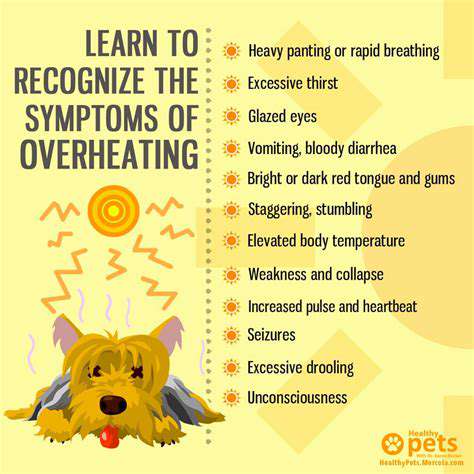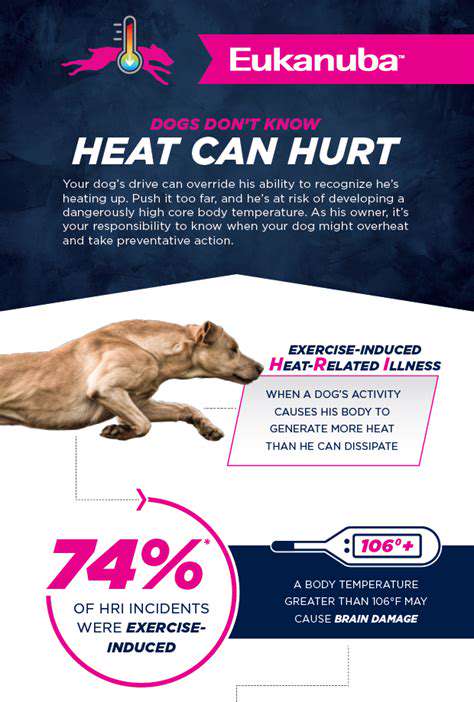The Importance of Preventing Overheating in Dogs
Why Dogs Are Prone to Overheating
Physiological Factors Contributing to Overheating
Dogs have a different physiological makeup compared to humans, particularly when it comes to thermoregulation. They primarily sweat through their paw pads and rely on panting to lower their body temperature. This natural cooling mechanism is less efficient, making them more vulnerable to overheating, especially in high temperatures.
The presence of a thick fur coat can further exacerbate this issue. While some breeds have coats designed to keep them cool in hot environments, others, particularly those with double coats, can trap heat. This makes it essential for dog owners to recognize the signs of overheating and take proactive measures to keep their pets comfortable.
Additionally, certain breeds are more susceptible to heat-related issues due to their physical structure. Brachycephalic breeds, such as Bulldogs and Pugs, have short snouts that can hinder their ability to pant effectively. This characteristic increases their chances of overheating, especially during physical exertion or exposure to warm conditions.
Environmental and Situational Risks
The surrounding environment plays a crucial role in a dog's risk of overheating. On hot, humid days, temperatures can soar quickly, presenting a particular risk for dogs left in vehicles, even for short periods. Cars can heat up to dangerous levels within minutes, turning a seemingly harmless errand into a life-threatening situation for a dog.
Engaging in strenuous activities, such as running or playing fetch, during peak heat hours can also lead to overheating. During the summer, it's crucial to limit exercise routines to cooler parts of the day, such as early mornings or late evenings, to reduce the risk of heat-related stress.
Finally, factors such as obesity, age, and underlying health conditions can predispose certain dogs to overheating. Overweight dogs may have difficulty regulating their body temperature and are more likely to become overheated due to their larger body mass. Responsible pet ownership involves understanding these risks and making informed decisions when caring for dogs in warm weather.
Signs of Overheating in Dogs

Physical Symptoms of Overheating
One of the primary indicators that a dog is overheating is excessive panting. Panting helps dogs regulate their body temperature, but if it becomes pronounced and continues, it signals a serious issue. Other physical symptoms can include drooling, bright red gums, and an elevated heart rate.
As the body's temperature continues to rise, dogs may show signs of weakness, lethargy, or even confusion. Recognizing these symptoms early is crucial for the dog’s well-being, as they can quickly escalate to heatstroke. Observing changes in behavior, such as reluctance to move or a sudden increase in restlessness, should prompt immediate action.
In severe cases of overheating, dogs can collapse or experience seizures. Veterinary attention is urgently needed if your dog shows these extreme symptoms. Understanding the physical signs of overheating can help pet owners take proactive measures to protect their animals.
Environmental Factors Contributing to Overheating
Several environmental factors can increase the risk of your dog overheating. High temperatures are the most obvious concern, especially during the summer months when dogs are more susceptible. Additionally, humidity can cause discomfort and impede a dog's ability to cool down effectively.
Other contributing factors include limited access to shade and water. Outdoor areas without adequate cover can create dangerous conditions for pets, as they may not have a place to escape direct sunlight. Even seemingly minor activities, such as a long walk or play session, can become hazardous in hot weather.
Dogs with thick fur or brachycephalic breeds (such as pugs and bulldogs) are particularly at risk in extreme heat. Understanding these environmental risks allows dog owners to make informed decisions for their pets’ safety. Creating a comfortable environment can significantly reduce the likelihood of overheating incidents.
Preventative Measures to Avoid Overheating
To prevent overheating, it's essential to establish a safe regimen for your dog during hot weather. Regular hydration is critical; always ensure that your dog has access to fresh, cool water. Taking breaks during physical activity can help monitor your dog's temperature and prevent overheating, allowing them to cool down as needed.
Timing outdoor activities is also vital. Early mornings or late evenings are the best times for walks when temperatures are cooler. Additionally, consider the surfaces your dog walks on, as hot pavement can also contribute to overheating and injuries.
Lastly, grooming plays a role in preventing overheating. Regular brushings can help remove excess fur and undercoat, providing better airflow and cooling. Investing in quality grooming tools and maintaining your dog's coat can be a game-changer during heat waves, enhancing their comfort and safety.
Preventive Measures to Avoid Overheating
Recognizing the Signs of Overheating
Understanding the symptoms of overheating is crucial for dog owners. Dogs cannot sweat like humans do, and they rely on panting and other behaviors to regulate their body temperature. Symptoms of overheating include excessive panting, drooling, and rapid heart rate.
If you notice your dog is becoming lethargic, has difficulty breathing, or experiences vomiting, these may be clear indicators that they are overheating. Awareness of these signs allows for immediate action, which can make a difference in preventing heatstroke.
Dogs with shorter snouts, such as Bulldogs and Pugs, are especially vulnerable to heat. Their unique facial structure limits their ability to pant effectively, increasing their risk of overheating even in moderately warm conditions.
Always monitor your dog during hot weather or strenuous activities. Regularly checking their breathing and energy levels will help you assess whether they are becoming too warm and require immediate cooling.
Effective Cooling Methods for Dogs
When a dog shows signs of overheating, it is vital to cool them down quickly. One effective method is to provide them with a cool, shaded area. Moving them indoors or to a shaded spot can help reduce their body temperature significantly.
You can also use water to cool down your dog. Gently spraying them with cool water or immersing them in a kiddie pool can be very effective. However, avoid using ice-cold water as it can cause shock.
Cooling mats and vests are excellent preventative tools. These specially designed products can provide constant relief by absorbing and dissipating heat. Make sure to choose a mat or vest that’s appropriate for your dog’s size and weight for optimal effectiveness.
Additionally, encourage your dog to drink water frequently. Hydration plays a crucial role in temperature regulation, so always have fresh water available, especially during hot days or after exercise.
Planning Outdoor Activities Wisely
To prevent overheating, it is essential to plan outdoor activities during cooler parts of the day. Early morning or late evening walks are the best times to take your dog outside when temperatures are generally lower.
Consider the length and intensity of the exercise. Instead of a prolonged run, opt for shorter walks with plenty of breaks. Always be mindful of your dog's physical condition and adjust the pace to ensure they are comfortable.
When participating in outdoor events, provide frequent breaks in the shade or under a sun shelter. This allows your dog to rest and recover from the heat, making the activity both enjoyable and safe for them.
Lastly, keep an eye on the local weather forecast. On particularly hot days, it might be better to skip outdoor activities altogether in favor of indoor play which can include training exercises or interactive puzzle toys to keep your dog engaged.
What to Do if Your Dog Overheats

Recognizing the Signs of Overheating
Dogs cannot cool down as efficiently as humans do, which makes it crucial for owners to recognize the early signs of overheating. One of the most common symptoms is excessive panting, which occurs as they try to regulate their body temperature. Other indicators include drooling, lethargy, and a bright red or pale tongue. If you notice your dog acting unusually, such as refusing to drink or lying down and not moving, you should take action quickly. The sooner you identify overheating, the better chances there are for a full recovery.
Pay attention to your dog’s breathing patterns as well. Rapid or labored breathing can be a warning sign that your dog is struggling to cool down. Additionally, check if they are experiencing any form of disorientation, as this could indicate heat exhaustion. Be proactive in observing changes in behavior or physical condition, especially during hot weather or after intense exercise.
Another symptom of overheating is an elevated heart rate. If you suspect that your dog is overheated, you can measure their heart rate by placing your hand on their chest. A rapid heartbeat can be an alarm sign, prompting immediate intervention.
In some cases, you may even see signs of vomiting or diarrhea as the body tries to cope with the extreme heat. If these symptoms are present, it is critical to get to a cool environment and contact your veterinarian.
Always err on the side of caution. If you suspect your dog is overheated despite not showing all symptoms, it’s better to take preventive measures as opposed to waiting until conditions worsen.
Immediate Actions to Take
If you find that your dog is overheating, acting quickly can prevent serious health issues. The first step is to move your dog to a shaded or air-conditioned area immediately. This can help lower their body temperature and provide relief from the heat.
Next, you should offer them cool water to drink. Hydration is essential for helping your dog recover from the heat. Avoid giving them ice-cold water, as this can shock their system; instead, aim for cool, not icy, water.
Another effective method is to wet their fur with lukewarm water. Use a towel or sponge to soak their body, paying special attention to the ear flaps, paws, and belly, as these areas can cool the body more rapidly. You can also use fan airflow to aid the cooling process.
If your dog shows no signs of improvement within a few minutes, it's vital to contact your veterinarian for further advice. They may need to undergo more extensive treatments to manage their body temperature effectively.
Monitor your dog's behavior closely after cooling measures have been initiated. A sudden slump or unresponsiveness could be indicative of more serious conditions, necessitating immediate medical attention.
Preventative Measures for Future Incidents
To prevent overheating incidents, it’s essential to establish a routine that keeps your dog safe during hot days. One of the best practices is to limit outside activities during peak heat hours, which are typically between 10 a.m. and 4 p.m.
Always ensure your dog has access to fresh, cool water while outside. Dehydration can exacerbate the risk of heat overexposure, so keeping their water bowl filled is crucial. You can also consider freezing a bowl of water for them to play with, providing both hydration and entertainment.
Investing in cooling products, such as cooling mats or vests, can help your dog regulate their body temperature during hot weather. These products are designed to provide a cooling effect that can be invaluable during outdoor activities.
Another important aspect is to monitor your dog’s weight and overall health. Obesity can significantly increase the risk of overheating. Keeping your dog fit through regular exercise can help lower the chances of them becoming overheated in the first place.
Lastly, educating yourself about your dog’s breed is essential. Some breeds, especially brachycephalic (short-nosed) dogs, are more prone to heat-related issues, making it crucial for their owners to take particular precautions during warm weather.